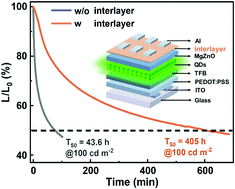Boosting the efficiency and stability of green InP quantum dot light emitting diodes by interface dipole modulation†
Abstract
The interface states have significant effects on the optoelectronic properties of quantum dot-based light emitting diodes (QLEDs). Herein, we employed a dielectric interlayer, namely, phenylethylammonium bromide (PEABr):methylammonium bromine (MABr), in indium phosphide (InP) QLEDs to modulate the interfacial charge transfer via inducing the formation of interface dipoles. The PEABr:MABr interlayer was deposited between the electron transport layer (ETL) of MgZnO (MZO) nanoparticles and the metal Al cathode to simultaneously enhance the ETL/Al interfacial contact for minimizing the contact resistance and modifying the conduction band minimum (CBM) of the ETL to prevent the over injection of electrons, leading to improved charge balance within the QLEDs. Besides, the surface defects on the MZO ETL can be passivated with the aid of Br filling, favoring the enhancement of the radiative recombination efficiency in the QDs of the emitting layer (EML). As a result, the efficiency and the operational lifetime of the resultant green InP QLED are enhanced by more than 2-fold and 9-fold, respectively, achieving a maximum external quantum efficiency (EQE) of 7.8% and an operational lifetime of over 400 h.



 Please wait while we load your content...
Please wait while we load your content...